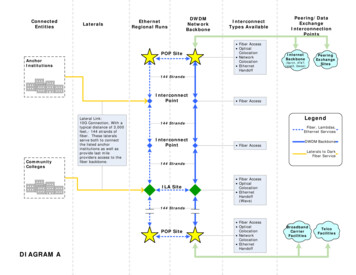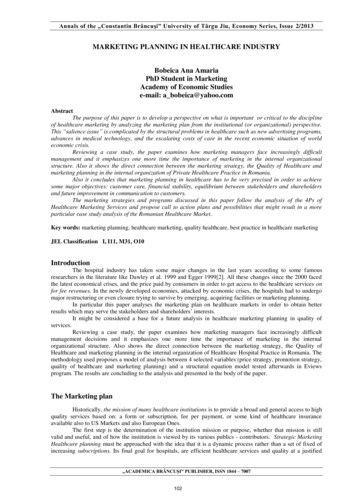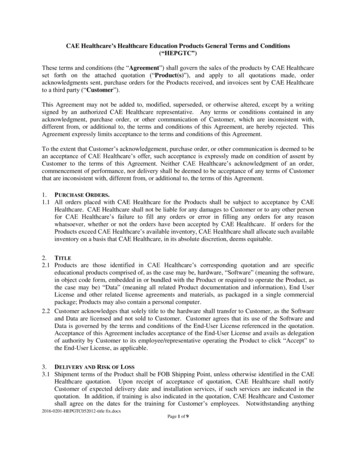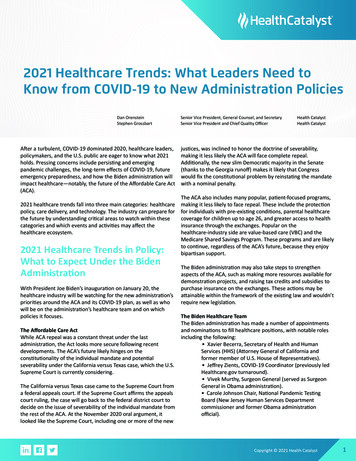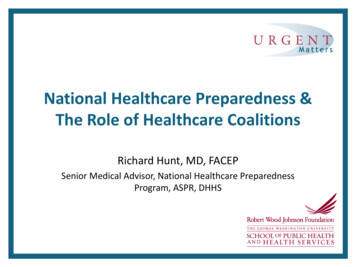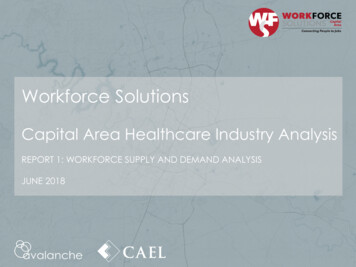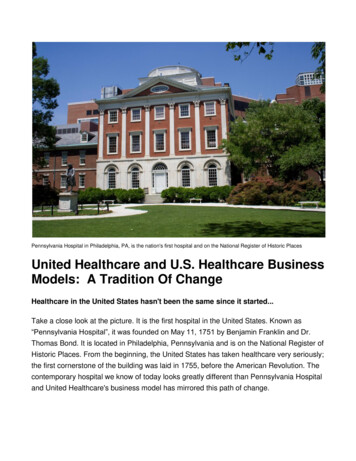
Transcription
Pennsylvania Hospital in Philadelphia, PA, is the nation's first hospital and on the National Register of Historic PlacesUnited Healthcare and U.S. Healthcare BusinessModels: A Tradition Of ChangeHealthcare in the United States hasn't been the same since it started.Take a close look at the picture. It is the first hospital in the United States. Known as“Pennsylvania Hospital”, it was founded on May 11, 1751 by Benjamin Franklin and Dr.Thomas Bond. It is located in Philadelphia, Pennsylvania and is on the National Register ofHistoric Places. From the beginning, the United States has taken healthcare very seriously;the first cornerstone of the building was laid in 1755, before the American Revolution. Thecontemporary hospital we know of today looks greatly different than Pennsylvania Hospitaland United Healthcare's business model has mirrored this path of change.
New medicine, new business models The healthcare industry is steadily moving away from its traditional business models.Patient care clinics in CVS Health, Walgreens, Walmart and other pharmacy retailers areone example. Another example is the growing number of increasingly advancedprocedures performed outside of hospitals and conducted by independent surgical centers.United Healthcare's business model has exploded past its original borders as a health planorganization and has taken on new roles as a care and healthcare services provider.UHC as a healthcare provider.Last year, United Healthcare (UHC) acquired MedExpress for 1.5 billion dollars.MedExpress operates urgent care centers in 14 states: Alabama, Arkansas, Delaware,Florida, Illinois, Indiana, Kansas, Maryland, Massachusetts, Michigan, Minnesota, NewJersey, Oklahoma, Pennsylvania, Tennessee, Virginia and West Virginia. The organizationbecame part of UHC’s Optum business unit which operates 9 urgent care facilities locatedin Kansas and Texas (known as Optum Clinic Urgent Care). Optum also has a largescale PBM, a home infusion and a healthcare data provider unit within its business. Thedata unit provides analytics and insights across an array of healthcare stakeholdersincluding employers, physicians, hospitals, researchers, pharmacies, governments andother entities.Urgent care centers typically provide a wider and more advanced selection of services thanthe typical care provided by clinics in retail pharmacies. The urgent care facilities are oftenstaffed with a medical doctor whereas the retail pharmacy care center clinician is typicallynurse practitioner. Often outfitted with additional staff and equipment, such as x-raymachines, urgent care centers can treat more complex cases.The "org chart" is getting deeper and wider .UHC’s position as an insurer and provider is rapidly materializing and defining itself. Todate, their model does not include a hospital. It does have a home infusion unit, AxelaCare,which it acquired last year. This organization is also part of UHC’s Optum unit. AxelaCareoperates in 44 states and has 34 pharmacies.
The urgent care clinics are also distributed across multiple states. In a recent earnings call,a UHC executive implied their plans for expansion would reach into 75 markets. While thetotal number of patients and dollars in care do not approach the scope and quantity of thelarger integrated delivery networks, UHC’s role as a provider has advanced significantly ina short amount of time.For comparison Two very established plan and care provider organizations are Kaiser Permanente andIntermountain Healthcare. Each has been round for years with strong regional and selectmetropolitan market positions. They serve as good examples plans may choose to follow ifthey choose to enter the provider sector. A third, more recent example of a plan alsobecoming a provider is Highmark. Highmark is an independent licensee of the Blue CrossBlue Shield Association and it acquired West Penn Allegheny Health Systems in 2013 forabout 1 billion dollars. West Penn Allegheny Health System, now known as AlleghenyHealth Network, is comprised of 7 hospitals, 1,700 physicians and 17,000 employees. Itwas having financial issues prior to it being acquired by Highmark but reportedly cleared amodest profit roughly a year after its acquisition was approved by regulators.A new approach to the business and clinical sides of healthcare For UHC, controlling costs and standardizing care is now more within their grasp. Byoperating their own provider organizations, they can more closely align care, benefitdesigns and protocols for more types of patients and conceivably better manage totalcosts. An additional consideration for UHC and the addition of urgent care facilities isemergency room visits. Treatment in the emergency rooms of hospitals is traditionally veryexpensive. By offering a selection of advanced care procedures via the urgent care setting,UHC is able to service a wider variety of patients to bring in more revenue plus avoidpaying the higher cost of an emergency room visit. They can also provide care for otherhealth plan members, not just UHC plan members.
Possible plans for the future in the provider sector.Based on these details, in a short amount of time, UHC has taken limited but assertivesteps in reducing the amount of claims paid to outside provider entities and widened itsrevenue streams to include dollars from members outside of their own plans. There isplenty of room for more acquisitions for UHC or other entities to make inroads as a careprovider via urgent care centers. Nextcare, FastMed, AFC Doctors Express, CareSpot,Patient First and Doctors Care are urgent care provider chains with more than 50 unitseach.Another large, less likely target is Concentra. Formerly owned by Humana, they sold itback to the investment company it was bought from; Carson, Anderson & Store and theirpartner, Select Medical Holdings (a rehab hospital operator), for just over 1 billion dollarsin early 2015. Surgery center chains, such as AmSurg, Constitution Surgery Alliance,Merritt Healthcare and United Surgical Partners may also be options for UHC and otherplans to integrate provider care within their organizations.Pluses and minuses For patients, employers and clinicians, the integration/verticalization of health plan andprovider has pluses and minuses. It offers efficiencies and convenience in the continuum ofcare which may lead to lower cost and better care if properly orchestrated. Theseorganizations can also leverage themselves in certain markets against other healthsystems and other plans to compete on terms of care, cost and convenience. Conversely,they can also leverage themselves based on coverage/cost/care against consumers andemployers as they can dictate the cost and access to care based on being a healthcarebenefit plan and provider of care.
Uncertainties for clinicians For physicians, it’s a mixed bag. They may or may not have the freedom to practice asthey wish if they are employees of a vertically integrated plan/provider organization. Insome cases it may be easier to practice as they may not have to be so deeply concernedcertain charges they assign to patient care will be carved out, challenged by the plan, andpotentially reduce their reimbursement. Some physicians may not be comfortable with suchan organizational structure that aligns with the “corporatization” of healthcare that can beperceived as detracting from true individual patient care.Via acquisition of a non-profit business model plan, UHC grows further.As it was integrating the provider acquisitions over the course of the year, it furtherexpanded its plan business but via a regional, non-profit acquisition. In mid-2016, UHCacquired Rocky Mountain Health Plans (not to be confused with Intermountain Healthcare).While this acquisition was clearly not UHC's largest deal, it was unique in several ways.RMHP's business is very concentrated in western Colorado and comprised of about300,000 lives and also features Medicaid. Another different aspect are the necessarybuying arrangements involved. Since RMHP is non-profit, it will have to convert itsbusiness model from non-profit to for-profit and then sell its shares to UHC for the deal tobe completed.For 2017, another UHC business model emerges: a national ACO For 2017, UHC is launching a nationally branded accountable care organization (ACO) aspart of a value-based care push designed to attract self-fundedemployers. Called “NexusACO”, it has a national network of UnitedHealth’s “Tier 1” doctorsalready meeting the insurer’s quality and efficiency measures in place to care for patients.The plan and its goals are designed to guide enrollees to providers with better outcomesand lower costs. While UHC already has contracts with more than 800 ACOs across thecountry, it is still seeking more assertive ways to improve care/cost balances and growtheir business beyond traditional health plan offerings and business models.
Healthcare has come a long way Take another look at Pennsylvania Hospital. Think about where we started healthcare inthe United States and how much change has taken place although clinical and financialcomplexities continue to spiral upward. Plans and providers have had numerous changesand challenges to consider since 1751. Let’s look forward to future changes in healthcareas inevitable and unstoppable but let's also appreciate the incredible advancements in careand service along the way.About the author.Thank you for reading this article. I am a healthcare marketer seeking a new opportunity.My background is healthcare marketing (products and services), managed care marketingand digital healthcare marketing.Connect with me via LinkedIn or Twitter itter.com/JohnGBareskyMy website has been a healthcare industry resource since 2004 y.com/ShareShare United Healthcare and U.S. Healthcare Business Mo dels: A Tradition Of Change Since 1751
United Healthcare's business model has exploded past its original borders as a health plan organization and has taken on new roles as a care and healthcare services provider. UHC as a healthcare provider. Last year, United Healthcare (UHC) acquired MedExpress for 1.5 billion dollars.
